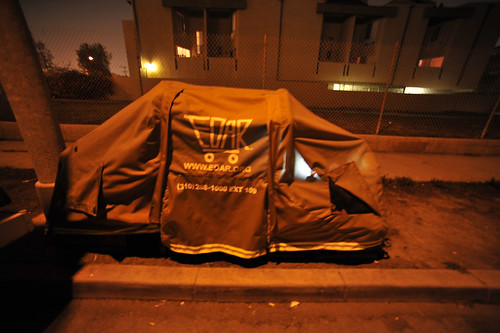Where I live there are quite a number of transient mobile home dwellers. I don’t know quite what the history of this is — I’m intrigued and only imagine at this point. It will take a more concerted effort to discover the larger story of why many people come here with their mobile homes and trailers, park them on the side streets of Venice Beach and effectively live there like that. It’s a different category of transience and homelessness than what I have been used to in the past such as, for example Seattle, Santa Cruz, Brooklyn or Manhattan where a box and a blanket or nothing was the stock shelter.
This shelter is constructed by EDAR – Everyone Deserves A Roof – creates an easy to establish structure that has its own wheel base for mobility and transforms into a cart of sorts for collecting and recycling during the day.
Why do I blog this? Two things are going through my mind. The first is the interesting relationships between a specific geographic place or city and the kinds of shelter for homeless and mobile transients you find there. So, all of these big RVs in Venice Beach – what’s the story there? Certainly I understand that going from a nice home to a trailer is a distinct possibility for people for a whole variety of reasons, I wonder why and how Venice Beach has become the place to drive those trailers?
The other things I’m thinking about is the “new interactive city” sorts of design/urban/ubiquitous/computing discussions and how these sorts of ‘below the grid’ designs and people and practices become part of this, or do not become a part of this. Either way could be argued to be desirable or not. For instance, staying off the grid, out of the database has a complex of normative arguments that come at the question of “on or off” from all sides. Off the grid, anonymous, beyond jurisdiction, microsocialnetworked, etc., could sound quite good and intriguing. It could also provide problems, say, if one is incarcerated with no database record – you could imagine the exception algorithm for the query dumping you into a Kafkaesque swamp of detention and rendition.
In any case, these EDAR structures are intriguing to me as design artifacts that do a simple thing to pull into context the activities of their intended owners in a really simple way. I’ve seen other homeless structures done by fancy architects who wear slender flat-front trousers and flat pointy shoes and they’re shit structural dome things that glow as they become occupied, meaning to raise awareness of the homeless problem in Los Angles. Which is crap concept architecture, if only because turning the lights on like this could make it (a) difficult to get a short night’s rest after a hot day of recycling, and (b) draw attention that may not be the ultimate goal of someone who has enough to worry about without being bothered or robbed. (If anyone can get me a pointer to that project I would appreciate it. I saw it a few years ago at a talk at USC from an LA based architect to whom I apologize for my rough but passionate crit above.)
Update — I recalled who it was from USC — Electroland who designed this Urban Nomad.
Continue reading Practice Observed: Designed For Rest And Activity
